
Features
Operations
Cessna’s Super Single: Flying the 400
Time was when the turbocharged Cessna Centurion and Beech Bonanza ruled the skies as the monarchs of the single-engine realm. Their dynasties have been toppled by more efficient composite kings boasting electronics that multiply a pilot’s safety, control and capabilities.
October 8, 2008 By Ken Armstrong
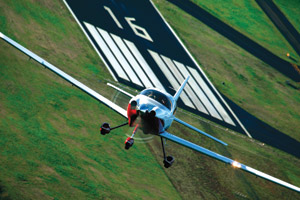
|
Time was when the turbocharged Cessna Centurion and Beech Bonanza ruled the skies as the monarchs of the single-engine realm. Their dynasties have been toppled by more efficient composite kings boasting electronics that multiply a pilot’s safety, control and capabilities.
By purchasing the bankrupt Columbia aircraft series Cessna has triumphed over the constant tweaking of its dated designs and leapt ahead with this top-end turbo. The Cessna 400’s closest competition includes the Cirrus SR 22 turbo and Mooney Acclaim M20TN. With equipped prices ranging from $466,000 to $620,000 US, these aircraft feature high-level comfort and performance to match – they are not entry-level machines for the financially or flying-hours challenged aviator. The Cessna 400 tops the list in complexity, capabilities and challenge and would be an excellent high-performance step-up for pilots with aspirations toward turbines.
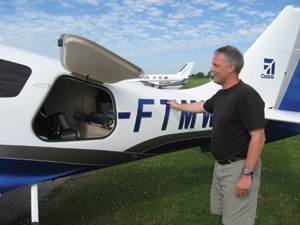
Owner Mike Woeller indicates the back of the extended baggage compartment.
|
Wings had the opportunity to evaluate Cessna 400 owner Mike Woeller’s machine with only 80 flight hours since new. The sleek Cessna stands large on the ramp with its tall, fixed gear and requires some twisting technique to enter the very comfortable front seats. The 50-inch-wide cabin is very roomy with a centre console between seats that sports a micro pad controlling all of the Garmin’s functions. Mike has purchased four aircraft from Cessna dealer Anna Pangrazzi but was searching the field for an aircraft that would suit his needs. When Cessna purchased Columbia’s assets the promise of its excellent customer support tipped the scales to the 400 acquisition. The Garmin 1000 dominates the panel and the entire plane’s fit and finish is state of the art according to Mike, who has looked at all the competition. I agree. Cessna wisely chose to change little on this aircraft with the exception of scrapping the Avidyne system for the superior Garmin avionics.
This Garmin 1000-directed aircraft has a very complete list of standard features thus reflecting the price. Moreover, its equipment list includes many components you will not normally find standard equipment in this class of aircraft. These include: speed brakes, emergency exterior access jettisonable canopy (like military jets), air conditioning, pressurized canopy seal, rudder hold, fuel system vapour suppression, dual/redundant electric system and built-in oxygen. It also boasts an exceptionally detailed POH that is akin to much higher-performance aircraft – partially due to a need to cover the relative complexity of this aircraft. At every turn one gets the impression the Cessna 400’s market niche is as a high-performance IFR platform – like a mini airliner – and we flew it accordingly.
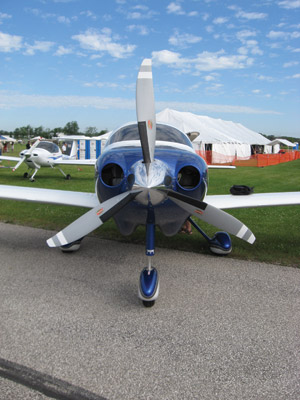
Seen here, Wings had the opportunity to evaluate Cessna 400 owner Mike Woeller’s machine with only 80 flight hours since new.
|
The baggage area is moderate in size with a 120-pound limit. There is an extended area into the tailboom for lengthy items with a 20-pound limit to avoid an aft C of G. The left/right/off fuel selector accesses the L/R wing tanks containing 102 gallons. Currently, only the prop is electrically deiced, but Cessna recommends the TKS aftermarket instillation for deice at a cost of $27,000. Mike’s plane does not have the airframe deicing and his conservative nature precludes him from penetrating cloud in below-freezing temperatures. He also limits his flights to 12,000 feet into headwinds to maintain high ground speeds. With tailwinds he will otherwise cruise at 20,000 feet or higher on oxygen. It should be noted that turbocharged aircraft have more efficiency and high cruising speeds at altitude. For instance, on the same fuel flow, at S/L the Cessna 400 will cruise 182 KTAS whereas 235 KTAS can be attained at its certified altitude of 25,000 feet. Higher altitudes also tend to avoid low-level turbulence and avoid most weather. Mind you, the 400 handles turbulence more effectively than its competition with the higher 25.5 pounds per square foot wing loading.
For our flight with only Mike and I aboard and 85 gallons of fuel, 30 pounds in the baggage area, we were approximately 150 pounds under the 3,600-pound gross. With full fuel (612 pounds), Mike’s machine has a useful load of 411 pounds. Sample C of G calculations for a Cessna 400 with an empty weight of 2,485 pounds show that 120 pounds of baggage in the main compartment, 270 pounds of passengers in the back seats and 380 pounds of pilots puts the balance point a safe half inch ahead of the aft limit. With this cabin load, only 57.5 gallons of fuel could be carried at take off and this would provide a range of better than 400 nm with VFR reserves.
A load challenging the forward C of G limit could consist of full fuel, two crew totaling 380 pounds and 123 pounds of additional payload in the rear seats placing the C of G at 108.85 – which is almost on the forward limit. In such a scenario, with heavier pilots, it would be wise to put much of the additional payload in the baggage area to stay within balance limits. With full fuel the Cessna can easily range more than 1,000 nm at economical cruise power.
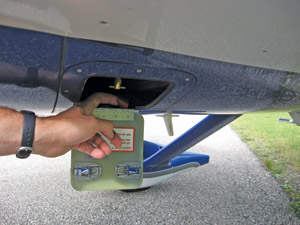
Mike shows the pull tab of emergency canopy release, a feature normally found in aircraft like military jets.
|
After start-up and safety checks of systems we taxi this king-designate to mile-long runway 27 at St. Thomas, Ont. with an OAT of 25C and a light crosswind. Directional control is by differential braking and the Cessna tracks very well. We inflate the cockpit canopy seal and the quiet aircraft becomes hush-like. Full power and takeoff flap gets us airborne at 75 knots after 1,600 feet with an initial climb rate of 1,300 fpm in the convectively choppy air at the 110 KIAS climb speed. To maximize the view over the nose with flap retraction we convert to 125 KIAS climbing 1,100 fpm at full power as dictated in the POH (fuel flow 37 gph). Mike’s plane is equipped with leading edge turbulator tapes which improve slow speed handing and stall characteristics. These strips do reduce the rate of climb by approximately 100 fpm, but do not affect cruising speed. We engage the rudder hold immediately after takeoff to effectively eliminate pedal anti-torque pedal force and set the Garmin GFC 700 digital autopilot to hold heading and climb speed. The turbochargers maintain the full power rating without adjustment to 10,000 feet where we level for more evaluations and set a mid-value cruise power of 30 inches MAP and 2,400 rpm (55 per cent). Full power is available to 18,000 feet and 85 per cent to 25,000 under ISA conditions. Electric aileron and elevator trim have perfect rates for trim change and as the controls load up with increasing airspeed I muse that pilots who like that heavy, solid, stable feeling of the bigger Cessnas will quickly be accustomed to the 400. Large control inputs require considerable force at 145 knots, but it’s quite possible to fly with only fingertip control otherwise. This control force gradient is likely prudent to help overcome any “ham-fisted” flying as this aircraft is not suitable/designed for sport/aerobatic type flying. Sleek aircraft like this Cessna can build up speed very quickly with minor nose-down pitch changes and most pilots will want to use the autopilot’s altitude hold feature as there is not a large margin between maximum cruise speed and Vne. (Additionally, I recommend pilots occassionally hand-fly their 400s to maintain manual finesse flying this thoroughbred. The problem with becoming dependent on an autopilot is that they can fail – and likely at the “wrong” time….
With an OAT of 8C.(12 degrees above standard ISA) at 10,000 feet our TAS was 173 knots at 55-per cent power. With the mixture set 85 degrees lean of peak the fuel flow was 14.6 gph. For the go-fast crowd, one could set 84-per cent power and cruise 203 KTAS on 18 gph, with a range of 675 nm. For the really economy-minded, the endurance setting of 45 per cent burns only 11 gph while providing a TAS of 143 knots at 1,000 feet asl – comparable efficiency to many four-place entry-level aircraft.
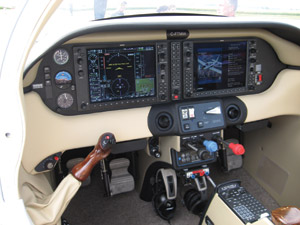
The Garmin 1000 dominates the panel and the entire plane’s fit and finish is state of the art.
|
The big six’s engine mounts eliminated any noticeable vibration. During all flight regimes the engine temperatures remained well within limits. The digital Garmin autopilot is heralded as a huge advance in A/Ps. It’s light weight, extremely reliable and has functions usually only found on business jets and aircraft of that ilk. Flying a sleek and slippery aircraft at fast speeds in an IMC terminal environment can create excessive workloads for some pilots and allowing the A/P to handle the aircraft provides more time to plan ahead and think through the approach or departure procedure.
Slow-speed handling is precise and stalls from clean with no power to full flap and approach power result in surprisingly small pitch and roll excursions. It should be noted that the aircraft would not be as placid in deeper stalls with an aft C of G and the POH wisely and justly points this out. The clean power-off stall arrived at 71 knots and the full flap stall with 15-inch MAP dipped around 53 knots at our operating weight of 3,400 pounds.
As we switched tanks to remain below the 10-gallon maximum differential between tanks we turned on the vapour suppression system to avoid potential vapour/air locks. This system must also be on during cruise above 18,000 feet and whenever the turbocharger Turbine Inlet Temperature (TIT) is above 1,460F to ensure a continuous fuel flow. On this note, the POH cautions not to reduce power in flight too much as the engine may not respond properly to power applications and if too low a power setting is selected, and with an improperly set up fuel system, the fuel pressure may drop below 5.5 psi triggering the fuel pump on and potentially flooding the engine and causing it to quit.
After confirming this Cessna’s fine handling it was time to visit the circuit – made busy during COPA’s annual convention. From our close proximity to St. Thomas, lowering the nose to descend into the circuit with power off would not only have supercooled the engine but also caused us to blitz through the circuit in a blur. The POH cautions not to allow the cylinders to cool below 240F in coasting downhill. Furthermore, minimal power settings can defeat turbocharger operation and cause the engine to quit! Enter the speed brakes…. A flip of a switch extends the brakes (with appropriate warning lights). There is no pitch change, buffeting airflow or noise. The nose is simply lowered slightly and 25-inch MAP set on the throttle and 165 KIAS on the ASI (or auto-pilot function) and the 400 plunges downwards at 2,200 fpm – it took considerable time afterwards for my ears to reach ground level…. It’s noteworthy that speed brakes inadvertently left extended do not appreciably affect the stalling speed or aircraft handling – other than increasing the drag slightly at circuit speeds and of course the runway takeoff distance…. I’m guessing the 25-inch MAP setting for a S/B descent is to avoid shock cooling the engine and perhaps reduce the rate of descent to the equivalent of a greased crowbar! Speed brakes not only minimize thermal shock, they can be life saving during an emergency descent technique should one need to vacate the high-level rarefied air promptly!
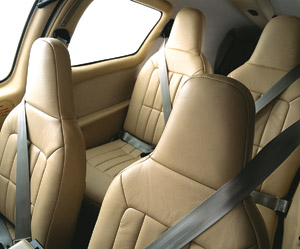
The 50-inch-wide cabin is very roomy.
|
Entering the circuit was straightforward and the takeoff setting of flap extendable at 127 KIAS helps hold the speed back while allowing some power to keep the engine warm. It’s been eight years since I evaluated the Columbia 300 but using the same circuit speeds and power worked well with 95 knots on base leg and slowing to 85 knots and dropping the full 40 degrees of flap on short final. This resulted in an easy flare and with light braking exiting at the first taxi intersection. The taxi time can be used toward the 5-minute turbo cooling requirement (to prevent oil coking) as long as the rpm does not exceed 1,200 rpm. The only time one notices any vibration in this aircraft is when the mixture is pulled full lean and the big engine’s compression shakes the bird like a dog shedding water. Reposing in a spiritual state in the cool cockpit my mind soars with thoughts of how far engines, airframe and avionics have progressed since the turn of the century and how this aircraft participates so well with these technological advances.
Hopefully, this evaluation adequately indicates the beneficial capabilities of the Cessna 400 while at the same hinting of the challenges related to flying a high-performance turbocharged single. Low-time or lackadaisical pilots should look elsewhere for their prospective aerial steed. Aviators flying conservatively with their brains ahead of their aircraft’s current position and with sound decision-making practices and a need to travel considerable distances at speed and often over the weather would do well to consider this Cessna. Initial acquisition and direct and indirect operating costs are not bargain-basement; however, for the well-heeled pilot this aircraft’s performance, quality of construction, amenities and the enhanced pecking order at the pumps could be a worthwhile investment.